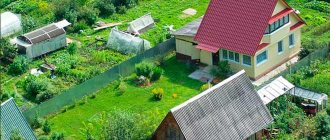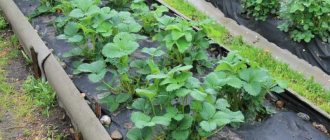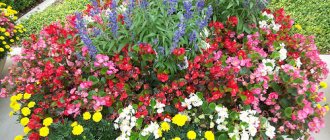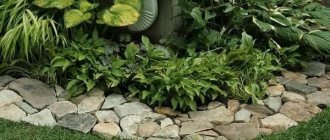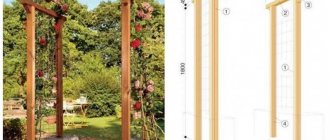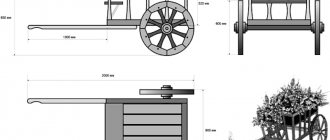All owners of personal plots try to decorate them from both a practical and decorative side. And for this it is necessary to think over a comfortable recreation area, arrange flower beds throughout the territory, and beautifully decorate the garden beds.
In this article we will look at how to make flower beds, what interesting ideas gardeners use for their design, where to start arranging a decorative garden, what plants can be combined in them and much other useful information.
How to beautifully decorate a garden at your dacha: types of flower beds
Many gardeners are interested in how to make flower beds so that they delight with aesthetics, functionality and ease of care. Here it is worth considering various factors: the correct choice of their location, the availability of communications (water for irrigation), the type of beds themselves, and much more.
By variety, garden beds are divided into:
- traditional . They are used mainly in small areas of garden plots;
- high . An excellent option both from an aesthetic point of view and for areas that are subject to mole invasion. The vertical arrangement of the beds visually increases the free space. Various materials are used for their arrangement: stone, concrete, straw mats;
- warm (multi-layer). They contribute to an early harvest. Such structures are an excellent alternative to greenhouses. The principle of their operation is that organic matter, when decomposed, releases energy, providing garden crops and flowers with heat;
- vertical _ They are convenient for growing low-growing garden crops and flowers even in a small area. They are constructed from any materials: metal mesh, plastic. It is important to consider here that the maximum permissible height of the structure should not exceed 70 cm, and the width should be 100 cm. This will allow you to conveniently care for the planted plants.
High beds as a way to obtain an intensive harvest
Even though this is a very labor-intensive process at first - building the frame itself and watering the beds, it will allow you to forget about the bad climate and low yields.
Aluminum barrels and containers of suitable shape are a good and easy-to-transport material for creating high beds
Beds fenced with stones
The high bed is always exposed to the rays of the sun, which helps to warm up the soil layer, so it can be planted as early as April without fear of freezing, and the lower mesh will prevent the invasion of moles and mice. A frame that is not too wide (within 150 cm) will allow you to care for the bed on both sides. If you divide it into two strips 80 cm wide, you can even make a greenhouse with your own hands by passing the film over both plantings. It is worth noting that it is the high beds that provide the earliest harvest of first salads and then fastidious vegetables. The only problem is more frequent watering, since water does not stay in such soil for a long time.
Raised beds (photo 1)
You can also try growing high beds with fragrant herbs in urban areas. They will become part of the decor (photo 2)
Despite all the difficulties at the beginning, the planting justifies the effort put into it and lasts a long time without bringing much trouble, and the garden bed looks beautiful.
The smart bed for fragrant herbs only needs to be dug once, before planting the seedlings. Then it requires a minimum of attention and care
Smart free-form bed
Creating a decorative vegetable garden: where to start
To create a vegetable garden with beautiful breasts with your own hands, you need to start by drawing up a thoughtful and competent plan - a drawing. The diagram is drawn taking into account the cultivation of both vegetable and ornamental crops in the beds. Here the fertility of the soil, what kind of vegetation it is suitable for, the location of groundwater and other factors are thought through. The drawing also shows the future shape of the beds, indicating the materials for their manufacture, the exact dimensions and location of the vegetation.
Smart bed
Smart garden beds are based on almost the same method as lazy beds, but with an emphasis on fertilizers. Many gardeners have been convinced more than once that high-quality fertilizer produces a large harvest that does not require much effort from its owner. Such a bed uses not ordinary soil as soil, but compost, to which straw, leaves and sawdust are added, which as a result provides even more useful substances for future plants. The compost heap is covered with a thin layer of soil, and after a month the bed on this soil will be suitable for planting. It can reach a height of up to one meter, but it can be fenced, like raised beds. It is best to use brick, wild stone or logs for this type of beds, which, in turn, will make them more beautiful. An internal irrigation system is also required.
Multi-level smart beds
Smart beds (photo 2)
This method will be good for those who can afford a large amount of fertilizer and time to build structures. But we can definitely say that the efforts made will fully pay off, you will get beautiful beds, and your garden will bear fruit several weeks before the usual time.
Wooden fences of smart beds can be decorated with brackets with metal carvings (laser cutting)
What materials can fencing for garden beds be made of?
Any garden bed must have fences. You can easily make them with your own hands from any available materials. For this purpose: wood is used (logs or boards, stones, bricks, cinder blocks, glass bottles).
Attention: the presence of fences on garden beds will prevent the loss of their aesthetics after heavy torrential rains.
Fences in the garden should be considered not only around the beds, but also around the garden area itself. For example, you can easily add a decorative touch to your garden by building a wicker fence, a hedge, a low decorative brick wall, or untreated stone.
Important: if the garden is located on a slope, there is a risk of soil erosion during heavy rains. Fences alone will not save the situation. Plants must be planted in special boxes.
BONUS: 5 super ideas and non-standard solutions
Decorating a vegetable garden is not only a useful activity, but also an exciting creative process. If you use your imagination and use your imagination, you can create an exclusive garden composition. A large number of improvised means and old things are used as decoration and small architectural forms.
DIY scarecrow Source eco-d-eco.ru
Children are often involved in this work. Children especially like to dress up the garden scarecrow. It scares away birds and serves as a decoration for the area.
Beautiful design of a small vegetable garden Source diz-cafe.com
How to combine flowers in flower beds
When choosing vegetation for planting, attention is paid to:
- sizes;
- decorative qualities;
- harmonious combination with each other;
- features of care.
Attention : not all vegetable crops and herbs can get along with each other in the same flower bed.
When arranging beds for flowers and vegetables, it is worth considering their compatibility with each other:
- strawberries look good and develop in the same area with beans, spinach, marigolds, garlic, lettuce;
- kohlrabi is planted together with cucumbers, lettuce, onions, and beets;
- beans can be planted with potatoes, cucumbers, strawberries, eggplants;
- carrots are combined with lettuce, onions, sage, tomatoes, peas;
- tomatoes grow with calendula, basil, nasturtium, parsley.
Idea 1. Vertical garden
The simplest vertical mini-beds, arranged in thick bamboo stems, save space. It is more convenient to care for plants planted in them than on a regular ridge, if only because you do not need to bend low. Different varieties of lettuce with burgundy and green leaves, sown alternately, will highlight the unusual arrangement of the bed.
Can't find any bamboo stems? No problem. Polypropylene pipes from construction materials will be an excellent replacement for them.
- 11 options for raised beds
An overview of all the different options for raised beds.
Features of caring for flower beds
As for the features of care, beds with flowers and vegetable crops need:
- regular watering. It can be done either manually, watering the plants from a bucket or watering can, or using drip irrigation. The second option is more convenient and functional. Moreover, drip irrigation can also be done with your own hands;
- mulching and loosening the soil. Mulching will prevent moisture evaporation, and loosening the soil will open up oxygen access to the root system of planted crops;
- applying fertilizers (mineral and organic);
- digging up the soil twice a year (spring and autumn);
- treatment of vegetable crops from diseases and pests.
Beautiful and comfortable
A lazy bed is a completely new approach to gardening, which will allow seedlings to grow on their own and produce several times more yield. It is based on a rule that states that digging and weeding the soil is prohibited, except for its preparation and planting itself. Even though constant weeding can remove weeds and fluff up the soil, sooner or later it will dry out and will not be able to provide sufficient moisture for crops.
Stone fences are an easy way to build a foundation for a garden bed on uneven terrain.
Compact beds in urban areas
Raised beds with trellises on a gravel plot
Idea 2. Vegetable garden in pots
For a small space like a parapet, ordinary flower pots are suitable. To create the best conditions for plant growth, each one should be planted in a separate container. Climbing crops such as cucumbers, peas, beans, and dwarf varieties of tomatoes are quite content with a small amount of space.
- Compact, beautiful, productive - DIY decorative garden
A landscape designer from Belarus shares his personal experience in creating a dacha ornamental garden.
The best herbs for your garden
Dill and fennel
To obtain greenery, they sow thickly, for umbrellas - less often. It is advisable to sow dill every 2 weeks until the end of summer. Young plants need plenty of watering.
1 - Dill, 2 - Thyme, 3 - Tarragon, 4 - Monarda, 5 - Melissa
Lovage
Grow through seedlings, seeds are sown in March. Planting seedlings in open ground - in early May. Further propagation is by dividing the bush.
Tarragon
It quickly disperses throughout the area, so it is advisable to think about protection. It is grown by seedlings in a similar way to lovage.
Mint
Easily grown by seedlings and dividing the bush. Seedlings are planted in the ground in July. Differs in self-seeding.
1 - Sage, 2 - Lovage, 3 - Mint, 4 - Basil, 5 - Oregano
Melissa
Less aggressive than regular mint. In harsh winters, the bush may freeze, so mulching with leaf litter and protection from snowless frosts is necessary.
Basil
An annual that requires warmth. Does not tolerate temperatures below 0 °C. They are grown by sowing seedlings in March and planted in open ground in early June. Responsive to feeding, needs watering.
Oregano
Not only a medicinal, but also an ornamental perennial plant. Oregano grows quickly, but still not as aggressively as mint and lemon balm. Gives self-seeding, which is easily removed. Optimal conditions are full sun and loose, well-drained soil with the addition of lime and humus. But in practice, you don’t have to bother yourself with careful selection and preparation of the planting site, unless you set the goal of getting a record harvest of green mass. Tolerates several hours of shade during the day without loss of decorative value and tolerates almost any soil. Only one thing is mandatory: the place should not be damp. The plant does not require fertilizing; watering is only required during drought.
Coriander
Annual. It is grown by sowing seeds in open ground in early May. Unpretentious, needs abundant watering.
Coriander
Thyme
Perennial ornamental plant for the foreground of the composition. It is grown by sowing seeds in open ground; adult plants can be easily taken from cuttings. After flowering, cut off the tops of the shoots of lushly growing species by about a third, then the clumps will be denser and more compact. pin species with long shoots to the ground as they grow - they take root well.
Sage
An unpretentious, spectacular perennial plant. Easily grown from seeds by sowing in open ground. To maintain decorativeness, curtains need to be divided every 3-4 years. Sage is divided in the spring when the shoot height is no more than 7–10 cm or after flowering in late August – early September.
Monarda
A wonderful perennial plant for the background. It is grown by sowing seeds in open ground. It blooms in July-August for up to 40–50 days with white, pale lilac, pink or red flowers. At the beginning of summer, during the active growth of shoots, the aroma is no less intense. If the soil is acidic, apply lime or chalk under planting. The plant belongs to the group of calciphiles (likes a high calcium content in the soil), so it is not necessary to add a deoxidizing agent in the fall; you can do this during planting.
Methods for controlling weeds on garden paths
It is necessary to fight weeds; this can be done in various ways.
Agrotechnical method
To minimize the number of weeds, seed material is carefully selected and processed before planting. Weeds are pulled out and mowed before they begin to bloom and form seeds. When digging paths, weed roots are selected.
Chemical method
It involves the use of special preparations that destroy weeds. Their choice is quite large, the results usually satisfy gardeners.
Biological method
Not the most popular method, which requires awareness and knowledge of the subject:
- To suppress weeds, plants that suppress them are used;
- weed-eating insects;
- viruses and phages that affect weeds;
- birds for eating weed seeds.
What do you need to create lazy beds?
A key role in the design of a summer cottage will be played by preparing the land for future planting of seedlings. With the right approach, this should be done in the fall, when the gardener can collect materials to mulch the soil with cones, sawdust or straw (covering the ground with one of the selected materials). Thanks to this process, the appearance of weeds that harm the soil is eliminated.
DIY lazy bed:
- Determine the height of the board that will act as a side, taking into account the location of the bed and the installation location.
- Connect the boards and remove the clamps.
- Turn the bed over and mark the place for installation, focusing on the illumination of the area.
- Install the bed by burying the corner beams 10-15 centimeters into the ground. Make sure that all sides are installed parallel to ground level. Line the bottom of the container with a metal mesh (protection against moles), and attach plastic pipes to the sides from the inside.
- Fill the soil and install a crop irrigation system.
- Plant seedlings and install an awning to protect the seedlings.
When choosing an irrigation system, you do not need to save money, but this does not mean that you need to choose the most expensive systems presented in hardware stores. It is best to give preference to mechanisms that work independently and are controlled by buttons, thanks to which the direct participation of the gardener is not required. Watering can be drip or automatic, depending on how often the summer resident visits his country house.
Before the start of the crop planting season, you need to dig up the soil, preparing it for seeds and seedlings. After the plants are planted, you should not touch the ground, because mulching will protect it from weeds and do all the necessary work. The only task that remains on the shoulders of the gardener is timely watering of the beds, which can be automated.
Idea 5. Beds in containers
A garter or reliable support, for example from stakes, will be needed for climbing plants planted in tin containers. Such beds need to be arranged in early spring, as soon as it gets warmer; then plant young seedlings in them, and in the summer, when they grow, you will get a real vegetable “jungle”!
- 7 Vegetables You Can Grow in Containers
Want to know how to save space and grow a compact plant without any extra effort? This can be done if only two conditions are met.
How to arrange greenhouses and greenhouses
Greenhouses are temporary shelters for plants, so they do not require a special place. And it is not necessary to place them next to the house, because this design does not need, for example, a heating system, which is often supplied by greenhouses, especially in areas with an unstable climate. It is only important to take into account that it is better to install a greenhouse where it is subsequently planned to grow other crops that require nutritious soil. For example, tomato seedlings.
The greenhouse should be placed where there is sun. It is the sun that will help create the desired atmosphere in this “warm house” for seedlings, so installing such a structure in the shade is pointless and even dangerous. The soil in a greenhouse installed in the shade will warm up very slowly. The location of the greenhouse is preferred from north to south so that the plants inside it receive the right amount of light. Moreover, when planting seedlings, it is important to remember that the northern area should be occupied by tall varieties, and the southern area by low bushes.
